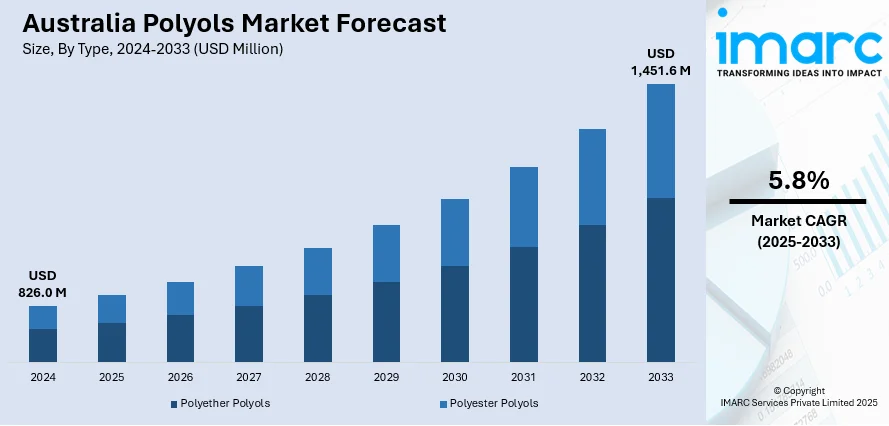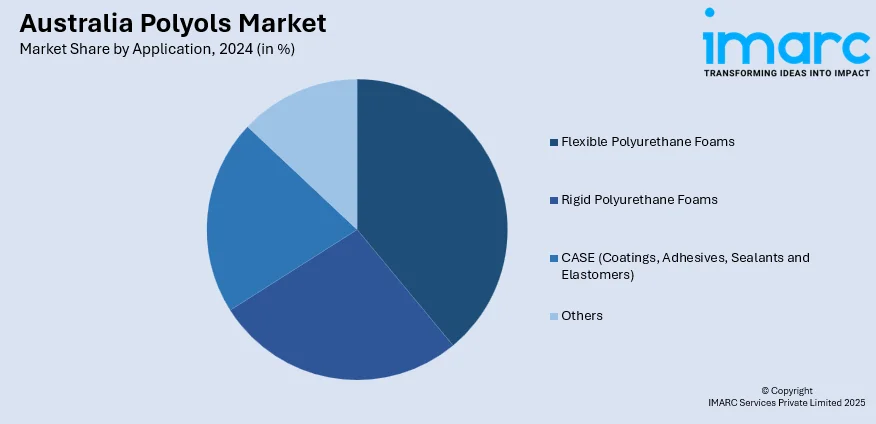
Australia Polyols Market Size, Share, Trends and Forecast by Type, Application, Industry, and Region, 2025-2033
Australia Polyols Market Overview:
The Australia polyols market size reached USD 826.0 Million in 2024. Looking forward, IMARC Group expects the market to reach USD 1,451.6 Million by 2033, exhibiting a growth rate (CAGR) of 5.8% during 2025-2033. The market in Australia is growing steadily, supported by rising demand in insulation, furniture, and automotive applications. Increasing focus on eco-friendly and energy-efficient materials, along with technological innovations, continues to support adoption across various end-user industries.
|
Report Attribute
|
Key Statistics
|
|---|---|
|
Base Year
|
2024 |
|
Forecast Years
|
2025-2033
|
|
Historical Years
|
2019-2024
|
| Market Size in 2024 | USD 826.0 Million |
| Market Forecast in 2033 | USD 1,451.6 Million |
| Market Growth Rate 2025-2033 | 5.8% |
Australia Polyols Market Trends:
Growing Demand Across End-Use Industries
The polyols market in Australia is being shaped by rising demand across several sectors, including construction, automotive, packaging, and consumer goods. The need for efficient thermal insulation in buildings, particularly in commercial and residential construction, is a major driver. Manufacturers are adopting polyols for producing rigid and flexible polyurethane foams due to their excellent insulation properties and lightweight structure. The shift toward reducing energy consumption and improving building efficiency is also encouraging the widespread adoption of polyol-based materials. Within the automotive sector, polyols are being increasingly used to develop lightweight interior components, helping companies meet fuel efficiency and emissions targets. Demand from the furniture and bedding industries is strong as well, driven by consumer preference for enhanced comfort and longevity. Developments such as the use of polyether and polyester polyols in high-resilience foam production are being explored by manufacturers aiming to improve performance and product quality. As industrial activities grow and end-users prioritize material performance and durability, the polyols market in Australia is expected to maintain a stable growth pattern in the near term.

To get more information on this market, Request Sample
Sustainability and Innovation Fueling Adoption
Sustainability targets and advancements in raw material sourcing are creating fresh momentum for the Australian polyols market. Companies are gradually shifting toward bio-based polyols derived from renewable sources, such as soy oil and castor oil, as part of their transition to more environmentally responsible practices. These alternatives offer comparable performance to petroleum-based polyols, with the added benefit of reducing greenhouse gas emissions and dependence on fossil fuels. In response to regulatory pressure and consumer awareness, manufacturers are increasing investment in research and product innovation. Hybrid formulations that combine traditional and green polyols are gaining popularity in Australia’s polyurethane production landscape. A notable development is the localized production of low-VOC polyols designed for use in interior applications, including mattresses and automotive seating. These changes align with the growing demand for safer, non-toxic, and low-emission materials. While production costs remain a challenge, especially for bio-based variants, the growing availability of raw materials and scale-up of processing capacity are expected to lower costs over time. Ongoing innovation, combined with rising demand for sustainable solutions, is likely to redefine market trends in the years ahead.
Australia Polyols Market Segmentation:
IMARC Group provides an analysis of the key trends in each segment of the market, along with forecasts at the country level for 2025-2033. Our report has categorized the market based on type, application, and industry.
Type Insights:
- Polyether Polyols
- Polyester Polyols
The report has provided a detailed breakup and analysis of the market based on the type. This includes polyether polyols and polyester polyols.
Application Insights:

- Flexible Polyurethane Foams
- Rigid Polyurethane Foams
- CASE (Coatings, Adhesives, Sealants and Elastomers)
- Others
The report has provided a detailed breakup and analysis of the market based on the application. This includes flexible polyurethane foams, rigid polyurethane foams, CASE (coatings, adhesives, sealants and elastomers), and others.
Industry Insights:
- Carpet Backing
- Packaging
- Furniture
- Automotive
- Building and Construction
- Electronics
- Footwear
- Others
The report has provided a detailed breakup and analysis of the market based on the industry. This includes carpet backing, packaging, furniture, automotive, building and construction, electronics, footwear, and others.
Regional Insights:
- Australia Capital Territory & New South Wales
- Victoria & Tasmania
- Queensland
- Northern Territory & Southern Australia
- Western Australia
The report has also provided a comprehensive analysis of all the major regional markets, which include Australia Capital Territory & New South Wales, Victoria & Tasmania, Queensland, Northern Territory & Southern Australia, and Western Australia.
Competitive Landscape:
The market research report has also provided a comprehensive analysis of the competitive landscape. Competitive analysis such as market structure, key player positioning, top winning strategies, competitive dashboard, and company evaluation quadrant has been covered in the report. Also, detailed profiles of all major companies have been provided.
Australia Polyols Market Report Coverage:
| Report Features | Details |
|---|---|
| Base Year of the Analysis | 2024 |
| Historical Period | 2019-2024 |
| Forecast Period | 2025-2033 |
| Units | Million USD |
| Scope of the Report |
Exploration of Historical Trends and Market Outlook, Industry Catalysts and Challenges, Segment-Wise Historical and Future Market Assessment:
|
| Types Covered | Polyether Polyols, Polyester Polyols |
| Applications Covered | Flexible Polyurethane Foams, Rigid Polyurethane Foams, CASE (Coatings, Adhesives, Sealants and Elastomers), Others |
| Industries Covered | Carpet Backing, Packaging, Furniture, Automotive, Building and Construction, Electronics, Footwear, Others |
| Regions Covered | Australia Capital Territory & New South Wales, Victoria & Tasmania, Queensland, Northern Territory & Southern Australia, Western Australia |
| Customization Scope | 10% Free Customization |
| Post-Sale Analyst Support | 10-12 Weeks |
| Delivery Format | PDF and Excel through Email (We can also provide the editable version of the report in PPT/Word format on special request) |
Key Questions Answered in This Report:
- How has the Australia polyols market performed so far and how will it perform in the coming years?
- What is the breakup of the Australia polyols market on the basis of type?
- What is the breakup of the Australia polyols market on the basis of application?
- What is the breakup of the Australia polyols market on the basis of industry?
- What are the various stages in the value chain of the Australia polyols market?
- What are the key driving factors and challenges in the Australia polyols market?
- What is the structure of the Australia polyols market and who are the key players?
- What is the degree of competition in the Australia polyols market?
Key Benefits for Stakeholders:
- IMARC’s industry report offers a comprehensive quantitative analysis of various market segments, historical and current market trends, market forecasts, and dynamics of the Australia polyols market from 2019-2033.
- The research report provides the latest information on the market drivers, challenges, and opportunities in the Australia polyols market.
- Porter's five forces analysis assist stakeholders in assessing the impact of new entrants, competitive rivalry, supplier power, buyer power, and the threat of substitution. It helps stakeholders to analyze the level of competition within the Australia polyols market industry and its attractiveness.
- Competitive landscape allows stakeholders to understand their competitive environment and provides an insight into the current positions of key players in the market.
Need more help?
- Speak to our experienced analysts for insights on the current market scenarios.
- Include additional segments and countries to customize the report as per your requirement.
- Gain an unparalleled competitive advantage in your domain by understanding how to utilize the report and positively impacting your operations and revenue.
- For further assistance, please connect with our analysts.
 Request Customization
Request Customization
 Speak to an Analyst
Speak to an Analyst
 Request Brochure
Request Brochure
 Inquire Before Buying
Inquire Before Buying




.webp)




.webp)












